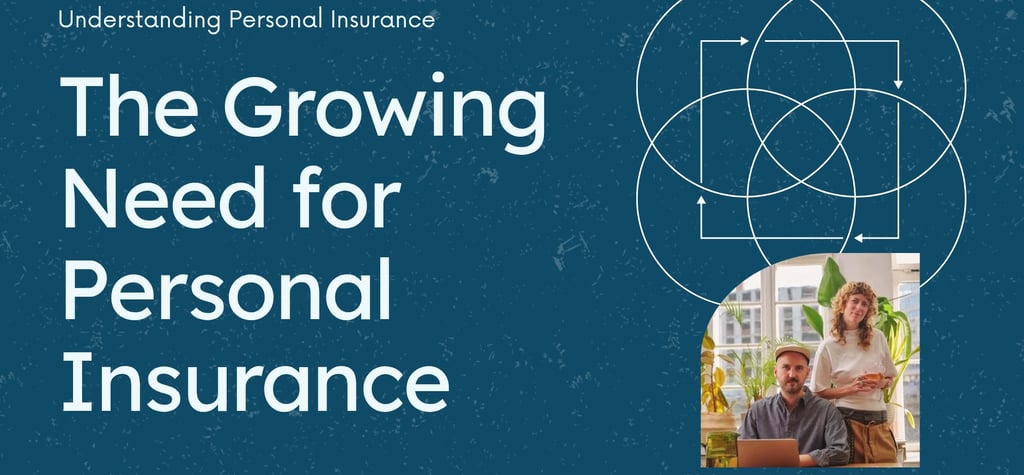The Growing Need for Personal Insurance in the USA: Statistics, Stories, and Solutions
INSURANCE


The Growing Need for Personal Insurance in the USA: Statistics, Stories, and Solutions
In today’s fast-paced world, personal insurance is no longer a luxury it’s a necessity. From health crises to unexpected accidents, having the right insurance coverage can mean the difference between financial stability and overwhelming debt. In the United States, where healthcare costs are among the highest globally, personal insurance provides a critical safety net. This article explores the current state of personal insurance in the USA, highlights the alarming number of uninsured individuals, shares a relatable story to underscore the importance of coverage, and offers guidance on choosing the best insurance options based on age and occupation.
The Current State of Personal Insurance in the USA
Recent data paints a sobering picture of insurance coverage in the United States. According to the U.S. Census Bureau, approximately 26 million people or 8% of the population were uninsured in 2023. This number reflects a slight increase from previous years, driven by factors such as the end of COVID-19 pandemic-related Medicaid protections and the expiration of enhanced Affordable Care Act (ACA) Marketplace subsidies. While this represents one of the lowest uninsured rates in history, millions still face significant financial and health risks without coverage.
Breaking down the data further:
Age Disparities: Young adults aged 19–25 are the most likely to be uninsured, with 14% lacking coverage in 2022. Working-age adults (19–64) have an uninsured rate of 10.9%, while children under 19 have a lower rate at 5.8%, largely due to programs like Medicaid and the Children’s Health Insurance Program (CHIP). Seniors aged 65 and older have near-universal coverage through Medicare, with less than 1% uninsured.
Demographic Trends: Hispanic adults face the highest uninsured rates at 24.8%, followed by Black adults at 10.4%. Non-Hispanic White and Asian adults have lower uninsured rates at 6.8% and 4.4%, respectively.
Economic Factors: About 64.2% of uninsured working-age adults cite high costs as the primary reason for lacking coverage. Many fall into a “coverage gap” in states that haven’t expanded Medicaid, earning too much to qualify for public programs but too little to afford private insurance.
Geographic Variations: Uninsured rates vary significantly by state, ranging from 2.4% in Massachusetts to 16.6% in Texas, largely due to differences in Medicaid expansion policies.
The financial consequences of being uninsured are dire. Nearly half (49%) of uninsured adults struggle to afford healthcare costs, and 62% report having medical debt, compared to 44% of insured adults. This debt can lead to long-term financial instability, as uninsured individuals often face unaffordable medical bills with little to no savings to cover them.
A Story of Why Personal Insurance Matters
Meet Sarah, a 28-year-old freelance graphic designer living in Austin, Texas. Like many young professionals, Sarah prioritized her career and creative pursuits over securing health insurance. She reasoned that she was young, healthy, and could save money by skipping coverage. Her freelance income was steady but modest, and the cost of private insurance seemed daunting.
One sunny afternoon, while biking to a coffee shop to meet a client, Sarah was hit by a distracted driver. The accident left her with a broken leg and a concussion, requiring emergency surgery and weeks of physical therapy. The hospital bills quickly piled up, totaling over $50,000. Without insurance, Sarah faced the full brunt of these costs. She drained her savings, maxed out her credit cards, and still owed thousands. The stress of medical debt delayed her recovery and forced her to take on extra work, despite her injuries.
Sarah’s story isn’t unique. Millions of Americans face similar scenarios, where a single accident or illness can lead to financial ruin. If Sarah had invested in a basic health insurance plan through the ACA Marketplace, her out-of-pocket costs could have been reduced to a manageable deductible and copays, potentially saving her tens of thousands of dollars. Her experience underscores a critical truth: personal insurance isn’t just about planning for the worst it’s about protecting your future.
Why Personal Insurance Is Essential Today
The need for personal insurance has never been greater. Here’s why:
Rising Healthcare Costs: The average annual deductible for employer-sponsored health insurance was $1,735 in 2023, and out-of-pocket costs continue to rise. Without insurance, even routine care can be prohibitively expensive.
Unpredictable Risks: Accidents, illnesses, and emergencies can strike anyone, regardless of age or health status. Insurance mitigates the financial impact of these events.
Legal and Financial Protection: Beyond health insurance, other types of personal insurance like auto, renters, or disability insurance protect against property damage, liability, and loss of income.
Peace of Mind: Knowing you’re covered allows you to focus on your career, family, and personal goals without the constant fear of financial catastrophe.
Choosing the Best Insurance Based on Age and Occupation
The right insurance depends on your age, occupation, income, and lifestyle. Below, we outline the best options for different groups, focusing on health insurance as the cornerstone of personal coverage, while also touching on other types like life, disability, and renters insurance.
Young Adults (Ages 19–34)
Profile: Often early in their careers, freelancers, gig workers, or entry-level employees. Many are healthy but may prioritize saving money over insurance.
Uninsured Rate: 14% for ages 19–25; 12.5% for ages 26–34.
Challenges: High premiums, limited employer benefits, and a sense of invincibility can lead to skipping coverage.
Best Insurance Options:
ACA Marketplace Plans: Young adults can find affordable plans with subsidies based on income. Bronze or Silver plans offer low premiums with higher deductibles, suitable for healthy individuals. For example, a 25-year-old earning $30,000 annually may qualify for a subsidized Silver plan with premiums as low as $100–$200/month.
Catastrophic Plans: Available for those under 30, these plans have low premiums but high deductibles, ideal for covering major emergencies.
Parental Plans: Under the ACA, young adults can stay on their parents’ insurance until age 26, a cost-effective option if available.
Renters Insurance: For young renters, a policy costing $15–$30/month protects personal belongings and covers liability.
Life Insurance: Term life insurance is affordable (around $20–$50/month) and recommended for those with dependents or student loans.
Example: A 25-year-old Uber driver in California might opt for a subsidized ACA Silver plan for health coverage and a renters insurance policy to protect their apartment, ensuring financial security without breaking the bank.
Working-Age Adults (Ages 35–64)
Profile: Mid-career professionals, small business owners, or self-employed individuals. Many have families and higher financial responsibilities.
Uninsured Rate: 10.9% for ages 19–64, with higher rates in low-income or non-Medicaid expansion states.
Challenges: Balancing family expenses with insurance costs, especially in industries without employer-sponsored plans.
Best Insurance Options:
Employer-Sponsored Plans: The most common coverage, insuring 53.7% of the population in 2023. These plans often include comprehensive health, dental, and vision coverage.
ACA Marketplace Plans: For self-employed or small business owners, Gold or Platinum plans offer lower deductibles, ideal for those with frequent medical needs.
Medicaid: Available for low-income adults in expansion states, covering 18.9% of the population.
Disability Insurance: Critical for professionals in high-risk occupations (e.g., construction workers) or those with dependents. Policies cost $50–$150/month, depending on coverage.
Life Insurance: Whole or term life insurance (around $50–$200/month) is essential for those with mortgages or children.
Example: A 40-year-old small business owner in New York might choose a Gold ACA plan for comprehensive health coverage, supplemented by a term life insurance policy to protect their family and a disability policy to safeguard their income.
Seniors (Ages 65+)
Profile: Retirees or those nearing retirement, often with chronic health conditions requiring regular care.
Uninsured Rate: Less than 1%, thanks to Medicare.
Challenges: Navigating Medicare options and supplemental coverage to cover gaps like prescription drugs or long-term care.
Best Insurance Options:
Medicare: Covers 18.9% of the population, providing near-universal coverage for seniors. Original Medicare (Parts A and B) covers hospital and medical services, while Part D adds prescription drug coverage.
Medigap: Supplemental plans (around $100–$300/month) cover out-of-pocket costs like co-pays and deductibles.
Medicare Advantage: An alternative to Original Medicare, these plans often include dental, vision, and wellness benefits, with premiums varying by provider.
Long-Term Care Insurance: For seniors planning for potential nursing home or in-home care, policies cost $100–$500/month based on age and health.
Example: A 70-year-old retired teacher in Florida might enroll in Medicare Part A and B, add a Medigap Plan G for comprehensive coverage, and purchase long-term care insurance to prepare for future needs.
High-Risk Occupations (e.g., Construction, Transportation)
Profile: Workers in physically demanding or hazardous jobs, often with inconsistent employer benefits.
Challenges: Higher risk of injury or disability, making comprehensive coverage critical.
Best Insurance Options:
ACA Marketplace Plans: Gold or Platinum plans ensure lower out-of-pocket costs for frequent medical needs.
Disability Insurance: Essential for replacing income in case of injury, with premiums ranging from $50–$200/month.
Workers’ Compensation: Often provided by employers, this covers workplace injuries but varies by state and industry.
Life Insurance: Term policies are affordable and provide peace of mind for families.
Example: A 35-year-old construction worker in Texas might opt for a Platinum ACA plan for robust health coverage and a disability policy to protect against job-related injuries.
Low-Income Individuals
Profile: Often in service industries, part-time roles, or unemployed, with limited financial resources.
Uninsured Rate: About 25% of working-age adults in poverty are uninsured.
Challenges: Affordability and access to coverage, especially in non-Medicaid expansion states
Best Insurance Options:
Medicaid: Available in 40 states and D.C. for low-income individuals, covering 18.9% of the population.
ACA Marketplace Subsidies: Subsidized plans can reduce premiums to $0–$50/month for those earning below 400% of the poverty level.
CHIP: For families with children, CHIP provides low-cost or free coverage.
Example: A 30-year-old server in Ohio might qualify for Medicaid or a heavily subsidized ACA Bronze plan, ensuring affordable access to care.
Tips for Choosing the Right Insurance
Assess Your Needs: Consider your health, dependents, income, and job risks. Young, healthy individuals may prioritize low-premium plans, while those with families or chronic conditions need comprehensive coverage.
Compare Plans: Use tools like Healthcare.gov or state-specific marketplaces to compare premiums, deductibles, and out-of-pocket costs.
Check Subsidies: Low- and middle-income individuals may qualify for ACA subsidies or Medicaid, significantly reducing costs.
Consider Additional Coverage: Life, disability, or renters insurance can provide comprehensive protection tailored to your lifestyle.
Consult a Professional: An insurance broker can help navigate options and find plans that fit your budget and needs.
Conclusion
Personal insurance is a critical tool for navigating life’s uncertainties, particularly in the USA, where healthcare costs can be astronomical. With 26 million Americans uninsured in 2023, the risks of going without coverage are clear: financial ruin, delayed care, and worsened health outcomes. Sarah’s story illustrates the devastating impact of being uninsured, but it also highlights the power of proactive planning. By choosing the right insurance based on your age, occupation, and financial situation whether through ACA Marketplace plans, employer-sponsored coverage, Medicaid, or Medicare you can protect your health and financial future.
